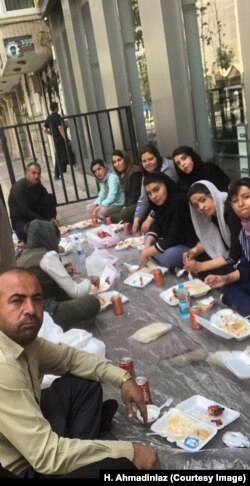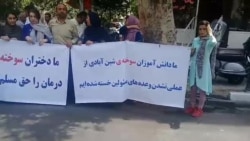A group of Iranian girls who suffered severe burns in a 2012 school fire have staged a protest in Tehran to draw attention to what they say are broken promises of government aid.
An Iranian lawyer representing the 11 girls sent VOA Persian several images showing them and their supporters gathered outside the compound of Iranian President Hassan Rouhani on Wednesday. One sign held by the girls said they were “fed up” with waiting for authorities to pay for medical treatment that they still need for injuries sustained in the December 5, 2012, accidental fire at an elementary school in the northwestern town of Shinabad. Another sign said the girls, who are from a predominantly ethnic Kurdish part of Iran, consider medical treatment to be an inalienable right.
The girls’ Tehran-based lawyer, Hossein Ahmadiniaz, told VOA Persian that they have been in the capital for a week while seeking meetings with Iran’s education and health ministers but have been turned down. He said they decided to rally near President Rouhani’s office on Wednesday to protest the apparent ministerial snubs.
WATCH: Iranian school fire survivors voice their complaints outside President Rouhani’s compound in Tehran
In a video clip sent by Ahmadiniaz, a girl who identifies herself as Ameneh Raad holds the camera, pointing it at the other girls with the signs and saying: “We, the Shinabad students are gathered near the doors of the presidential office because our medical treatment has stopped and our only request is to meet with the president. The authorities did not fulfill their promises.”
There was no immediate government reaction to the protest in Iranian state media.
The Shinabad school fire broke out in a faulty oil stove being used during winter to heat a classroom of girls ages 6 to 10. A staff member attempted to remove the stove while the students were still in the room and it exploded, causing injuries that killed two girls and left 26 other children suffering burns. Some of the surviving girls still need reconstructive surgery more than five years after the incident.
In December 2017, overseas rights groups published reports quoting Ahmadiniaz as complaining that the Iranian government was not providing a full blood money payment known as “Diyah” to the surviving girls or to the families of the two girls who died. Under Iran’s Islamic laws, Diyah is paid as financial compensation to victims or heirs of a victim in cases of murder, bodily harm or property damage. But Iran’s Diyah for women is half the value of that provided for men.
In an interview with the U.S.-based Center for Human Rights in Iran, Ahmadiniaz said the government was offering only half of a blood money payment to the Shinabad school victims because they were girls and called that “discriminatory and unfair.”
This report was produced in collaboration with VOA’s Persian Service.















